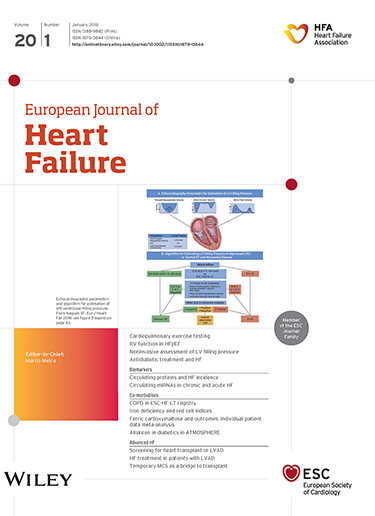晚期心力衰竭的多模态显像。ESC心力衰竭协会的临床共识声明。第二部分:机械循环支持和心脏移植。
IF 10.8
1区 医学
Q1 CARDIAC & CARDIOVASCULAR SYSTEMS
引用次数: 0
摘要
本临床共识声明概述了多模态成像在治疗晚期心力衰竭(HF)患者中的重要作用,特别是那些接受机械循环支持(MCS)和心脏移植(HT)的患者。对于临时和持久的MCS,多模态成像,主要是超声心动图,对于选择候选人,确保适当的设备放置和植入后的监测至关重要。术前,它有助于确定HF表型,评估心室功能,检测心内血栓,并评估瓣膜状况。主要测量指标包括心室大小、射血分数和心输出量。术中成像确保最佳设备放置和并发症检测。植入后超声心动图显示心脏和MCS之间的相互作用,发现早期并发症,评估心室卸载和右心室功能。连续成像评估对于患者和设备的管理以及并发症的诊断和治疗至关重要。在暂时性MCS中,影像学在脱机过程中至关重要。在移植后的各个阶段,从早期术后监测到长期随访,影像学都是至关重要的。超声心动图是一线技术。心血管磁共振提供心脏结构和功能的详细评估,提供对纤维化,水肿和心肌灌注的见解。冠状动脉计算机断层血管造影和正电子发射断层扫描是评估冠状动脉异体移植血管病变的可能选择。总的来说,多模态成像对于可能符合或正在接受MCS或HT的患者的综合管理至关重要,可以提高诊断准确性并指导治疗决策。本文章由计算机程序翻译,如有差异,请以英文原文为准。
Multimodality imaging in advanced heart failure. A clinical consensus statement of the Heart Failure Association of the ESC. Part 2: Mechanical circulatory support and heart transplantation.
This clinical consensus statement outlines the vital role of multimodality imaging in managing patients with advanced heart failure (HF), particularly those receiving mechanical circulatory support (MCS) and heart transplantation (HT). For both temporary and durable MCS, multimodality imaging, primarily echocardiography, is crucial for selecting candidates, ensuring proper device placement, and monitoring in the post-implantation period. Preoperatively, it helps to identify HF phenotypes, assess ventricular functions, detect intracardiac thrombi, and evaluate valvular conditions. Key measurements include ventricular size, ejection fraction, and cardiac output. Intraoperative imaging ensures optimal device placement and complication detection. Post-implantation echocardiography gives an impression of the interplay between heart and MCS, detects early complications, and evaluates ventricular unloading and right ventricular function. Serial imaging evaluations are essential for the management of the patient and the device and for diagnosing and treatment of complications. In temporary MCS, imaging is vital in the weaning process. Imaging is crucial across various post-transplant phases, from early postoperative monitoring to long-term follow-up. Echocardiography is the first-line technique. Cardiovascular magnetic resonance provides detailed evaluation of cardiac structure and function, offering insights into fibrosis, oedema, and myocardial perfusion. Coronary computed tomography angiography and positron emission tomography are possible alternatives for assessing coronary allograft vasculopathy. Overall, multimodality imaging is pivotal for comprehensive management of patients potentially eligible to or undergoing MCS or HT, enhancing diagnostic accuracy and guiding therapeutic decisions.
求助全文
通过发布文献求助,成功后即可免费获取论文全文。
去求助
来源期刊

European Journal of Heart Failure
医学-心血管系统
CiteScore
27.30
自引率
11.50%
发文量
365
审稿时长
1 months
期刊介绍:
European Journal of Heart Failure is an international journal dedicated to advancing knowledge in the field of heart failure management. The journal publishes reviews and editorials aimed at improving understanding, prevention, investigation, and treatment of heart failure. It covers various disciplines such as molecular and cellular biology, pathology, physiology, electrophysiology, pharmacology, clinical sciences, social sciences, and population sciences. The journal welcomes submissions of manuscripts on basic, clinical, and population sciences, as well as original contributions on nursing, care of the elderly, primary care, health economics, and other related specialist fields. It is published monthly and has a readership that includes cardiologists, emergency room physicians, intensivists, internists, general physicians, cardiac nurses, diabetologists, epidemiologists, basic scientists focusing on cardiovascular research, and those working in rehabilitation. The journal is abstracted and indexed in various databases such as Academic Search, Embase, MEDLINE/PubMed, and Science Citation Index.
 求助内容:
求助内容: 应助结果提醒方式:
应助结果提醒方式:


